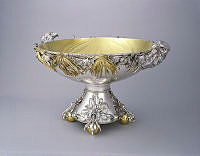Glass Locket with Jefferson Hair, White House Collection
This glass locket containing the hair of President Thomas Jefferson and his daughter Martha was acquired for the White House Collection in 1975 during the Gerald R. Ford presidency. The locket is attributed to Fossin et Fils, a prestigious Paris jewelry company that provided goods to King Louis-Philippe of France (1830–1848) as well as other European heads of state, and was produced circa 1825 to 1868.


